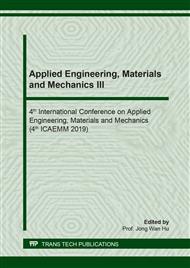[1]
M. Ahrens, Trends and patterns of US fire loss, National Fire Protection Association (NFPA) report Google Scholar, (2017).
Google Scholar
[2]
B. Reinicke, J. Axelsson, R. Hammarström, Bus and coach fires in Sweden and Norway, ed, (2006).
Google Scholar
[3]
J. H. Troitzsch, Fires, statistics, ignition sources, and passive fire protection measures, J. Fire Sci. 34 (2016) 171-198.
DOI: 10.1177/0734904116636642
Google Scholar
[4]
L. H.-s. Z. Xin-lei, S. Li-xia, Comprehensive Evaluation and Prediction of Fire Accidents in China Based on Statistics, China Safety Sci. J. 6 (2011).
Google Scholar
[5]
C. Q. Yang, Q. He, R. E. Lyon, Y. Hu, Investigation of the flammability of different textile fabrics using micro-scale combustion calorimetry, Polym. Degradation and Stability, 95 (2010) 108-115.
DOI: 10.1016/j.polymdegradstab.2009.11.047
Google Scholar
[6]
D. Gao, R. Li, B. Lv, J. Ma, F. Tian, J. Zhang, Flammability, thermal and physical-mechanical properties of cationic polymer/montmorillonite composite on cotton fabric, Compos. Part B: Eng. 77 (2015) 329-337.
DOI: 10.1016/j.compositesb.2015.03.061
Google Scholar
[7]
H. Yang, Q. Fu, X. Cheng, R. K. K. Yuen, H. Zhang, Investigation of the Flammability of Different Cables Using Pyrolysis Combustion Flow Calorimeter, Procedia Eng. 62 (2013) 778-785.
DOI: 10.1016/j.proeng.2013.08.125
Google Scholar
[8]
P. Wang, L. Xia, R. Jian, Y. Ai, X. Zheng, G. Chen et al. Flame-retarding epoxy resin with an efficient P/N/S-containing flame retardant: Preparation, thermal stability, and flame retardance, Polym. Degradation and Stability, 149 (2018) 69-77.
DOI: 10.1016/j.polymdegradstab.2018.01.026
Google Scholar
[9]
H. B. Zhao, Y. Z. Wang, Design and Synthesis of PET‐Based Copolyesters with Flame‐Retardant and Antidripping Performance, Macromolecular rapid commun. 38 (2017) 1700451.
DOI: 10.1002/marc.201700451
Google Scholar
[10]
E. N. Kalali, X. Wang, D.-Y. Wang, Multifunctional intercalation in layered double hydroxide: toward multifunctional nanohybrids for epoxy resin, J. Mater. Chem. A, 4 (2016) 2147-2157.
DOI: 10.1039/c5ta09482h
Google Scholar
[11]
Z. Li, L. Liu, A. J. González, D.-Y. Wang, Bioinspired polydopamine-induced assembly of ultrafine Fe (OH) 3 nanoparticles on halloysite toward highly efficient fire retardancy of epoxy resin via an action of interfacial catalysis, Polym. Chem. 8 (2017) 3926-3936.
DOI: 10.1039/c7py00660h
Google Scholar
[12]
K. Aschberger, I. Campia, L. Q. Pesudo, A. Radovnikovic, V. Reina, Chemical alternatives assessment of different flame retardants–a case study including multi-walled carbon nanotubes as synergist, Environ. Int. 101 (2017) 27-45.
DOI: 10.1016/j.envint.2016.12.017
Google Scholar
[13]
H. Chen, X. Wen, Y. Guan, J. Min, Y. Wen, H. Yang et al. Effect of particle size on the flame retardancy of poly (butylene succinate)/Mg (OH) 2 composites, Fire Mater. 40 (2016) 1090-1096.
DOI: 10.1002/fam.2355
Google Scholar
[14]
X. Liu, W. Wu, H. Qu, J. Sun, J. Xu, Flame-retarding and mechanical properties of flexible polyvinyl chloride with surface-treated lamellar magnesium hydroxide, J. Macromolecular Sci. Part B, 55 (2016) 115-127.
DOI: 10.1080/00222348.2015.1123212
Google Scholar
[15]
D. M. Molefe, J. Labuschagne, W. W. Focke, I. Van der Westhuizen, O. Ofosu, The effect of magnesium hydroxide, hydromagnesite and layered double hydroxide on the heat stability and fire performance of plasticized poly (vinyl chloride), J. Fire Sci. 33 (2015) 493-510.
DOI: 10.1177/0734904115612501
Google Scholar
[16]
P. Khalili, K. Tshai, D. Hui, I. Kong, Synergistic of ammonium polyphosphate and alumina trihydrate as fire retardants for natural fiber reinforced epoxy composite, Compos. Part B: Eng. 114 (2017) 101-110.
DOI: 10.1016/j.compositesb.2017.01.049
Google Scholar
[17]
ISO, ISO 3795: 1989. Road vehicles, and tractors and machinery for agriculture and forestry -- Determination of burning behaviour of interior materials, p.6.
DOI: 10.3403/00267673
Google Scholar
[18]
FMVSS, FMV 302 Flammability of interior materials, Federal Motor Vehicles Safety Standards.
Google Scholar
[19]
C. Miniguano, C. Byron, Study of the behavior in front of the fire of the materials used in the manufacture of the interior of bodywork and its incidence in the standardization of models and competitiveness of the bodywork company Industria Metálica Cepeda, Technical University of Ambato. Faculty of Civil and Mechanical Engineering, (2014).
Google Scholar
[20]
N. INEN, INEN 1323-2009, Ecuadorian standardization institute, motor vehicles and bus bodies.
Google Scholar
[21]
CEPE, Regulation No. 118 Economic Commission for Europe (CEPE) of the United Nations. Uniform technical prescriptions in relation to the behavior in front of the fire or to the capacity of the materials used in the manufacture of certain Categories of motor vehicles [2015/622], European Community Law Magazine, 102 (2013).
Google Scholar
[22]
E. D. Weil, S. V. Levchik, Flame Retardants in Commercial Use or Development for Unsaturated Polyester, Vinyl Resins, Phenolics, in Flame Retardants for Plastics and Textiles, ed: Carl Hanser Verlag GmbH & Co. KG, (2015) 187-203.
DOI: 10.3139/9781569905791.008
Google Scholar
[23]
E. D. Weil, S. V. Levchik, Flame Retardants in Commercial Use or Development for Epoxy Resins, in Flame Retardants for Plastics and Textiles, ed: Carl Hanser Verlag GmbH & Co. KG, (2015) 241-264.
DOI: 10.3139/9781569905791.010
Google Scholar


